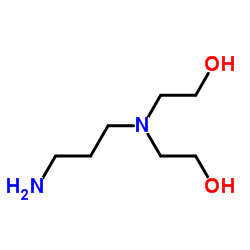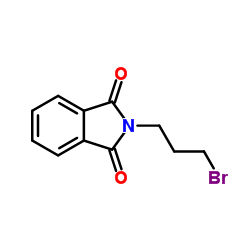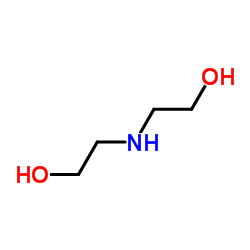4985-85-7
| 中文名 | N-(3-氨基丙基)二乙醇胺 |
|---|---|
| 英文名 | N-(3-Aminopropyl)diethanolamine |
| 中文别名 |
N,N-双(2-羟乙基)-1,3-二氨基丙烷
N-(3-氨丙基)二乙醇胺 |
| 英文别名 |
ethanol, 2,2'-((3-aminopropyl)imino)bis-
N,N-Bis(2-hydroxyethyl)-1,3-propanediamine N,N-Bis(2-hydroxyethyl)-1,3-diaminopropane N,N-Di(2-hydroxyethyl)-1,3-propanediamine 2,2'-((3-Aminopropyl)imino)diethanol 2-[3-aminopropyl(2-hydroxyethyl)amino]ethanol MFCD00047971 2,2'-[(3-Aminopropyl)imino]diethanol EINECS 225-642-0 2,2'-((3-aminopropyl)imino)bisethanol N-(3-Aminopropyl)diethanolamine Ethanol, 2,2'-[(3-aminopropyl)imino]bis- |
| 密度 | 1.1±0.1 g/cm3 |
|---|---|
| 沸点 | 316.5±22.0 °C at 760 mmHg |
| 分子式 | C7H18N2O2 |
| 分子量 | 162.230 |
| 闪点 | 145.2±22.3 °C |
| 精确质量 | 162.136826 |
| PSA | 69.72000 |
| LogP | -1.07 |
| 外观性状 | 无色液体带有一种微弱像鱼一样的气味 |
| 蒸汽压 | 0.0±1.5 mmHg at 25°C |
| 折射率 | 1.509 |
| 储存条件 | 避光,通风干燥处,密封保存 |
| 稳定性 | 常温常压下稳定 |
| 水溶解性 | 水溶性:可溶 |
| 分子结构 | 1、 摩尔折射率:44.80 2、 摩尔体积(m3/mol):150.0 3、 等张比容(90.2K):398.8 4、 表面张力(dyne/cm):49.9 5、 极化率(10 -24cm 3):17.76 |
| 计算化学 | 1.疏水参数计算参考值(XlogP):-1.7 2.氢键供体数量:3 3.氢键受体数量:4 4.可旋转化学键数量:7 5.互变异构体数量:无 6.拓扑分子极性表面积69.7 7.重原子数量:11 8.表面电荷:0 9.复杂度:74.8 10.同位素原子数量:0 11.确定原子立构中心数量:0 12.不确定原子立构中心数量:0 13.确定化学键立构中心数量:0 14.不确定化学键立构中心数量:0 15.共价键单元数量:1 |
| 更多 | 1. 性状:不确定 2. 密度(g/mL): 1.07 3. 相对蒸汽密度(g/mL,空气=1):不确定 4. 熔点(ºC):不确定 5. 沸点(ºC,常压):207 6. 沸点(ºC,3mmHg):不确定 7. 折射率(nD20):不确定 8. 闪点(ºC):138 9. 比旋光度(º):不确定 10. 自燃点或引燃温度(ºC):不确定 11. 蒸气压(kPa,25ºC):不确定 12. 饱和蒸气压(kPa,60ºC):不确定 13. 燃烧热(KJ/mol):不确定 14. 临界温度(ºC):不确定 15. 临界压力(KPa):不确定 16. 油水(辛醇/水)分配系数的对数值:不确定 17. 爆炸上限(%,V/V):不确定 18. 爆炸下限(%,V/V):不确定 19. 溶解性:不确定 |
|
N-(3-Aminopropyl)diethanolamine
Revision number: 1
SAFETY DATA SHEET Section1. BASE INFORMATION Product name:N-(3-Aminopropyl)diethanolamine Revision number:1 Section2. HAZARDS IDENTIFICATION Classification of the GHS PHYSICAL HAZARDSNot classified HEALTH HAZARDS Category 1C Skin corrosion/irritation Serious eye damage/eye irritationCategory 1 Not classified ENVIRONMENTAL HAZARDS GHS label elements Pictograms or hazard symbols Signal wordDanger Hazard statementCauses severe skin burns and eye damage Precautionary statements [Prevention]Do not breathe. Wash hands thoroughly after handling. Wear protective gloves/eye protection/face protection. [Response]IF INHALED: Remove victim to fresh air and keep at rest in a position comfortable for breathing. IF SWALLOWED: Rinse mouth. Do NOT induce vomiting. IF IN EYES: Rinse cautiously with water for several minutes. Remove contact lenses, if present and easy to do. Continue rinsing. IF ON SKIN (or hair): Remove/Take off immediately all contaminated clothing. Rinse skin with water/shower. Wash contaminated clothing before reuse. Immediately call a POISON CENTER or doctor/physician. Store locked up. [Storage] [Disposal]Dispose of contents/container through a waste management company authorized by the local government Section3. COMPOSITION/INFORMATION ON INGREDIENTS Substance/mixture:Substance Component(s):N-(3-Aminopropyl)diethanolamine >90.0%(GC) Percent: CAS Number:4985-85-7 N,N-Bis(2-hydroxyethyl)-1,3-diaminopropane Synonyms: Chemical Formula:C7H18N2O2 N-(3-Aminopropyl)diethanolamine Section4. FIRST AID MEASURES Inhalation:Remove victim to fresh air and keep at rest in a position comfortable for breathing. Immediately call a POISON CENTER or doctor/physician. Skin contact:Remove/Take off immediately all contaminated clothing. Gently wash with plenty of soap and water. Immediately call a POISON CENTER or doctor/physician. Eye contact:Rinse cautiously with water for several minutes. Remove contact lenses, if present and easy to do. Continue rinsing.Immediately call a POISON CENTER or doctor/physician. Ingestion:Immediately call a POISON CENTER or doctor/physician. Rinse mouth. Do NOT induce vomiting. burning sensation, difficulty in breathing, thirst, asthma, nausea, vomiting, bronchitis , Symptoms/effects: diarrhoea, weakness, collapse, headache, redness, pain, burn A rescuer should wear personal protective equipment, such as rubber gloves and air- Protection of first-aiders: tight goggles. Section5. FIRE-FIGHTING MEASURES Suitable extinguishingDry chemical, foam, water spray, carbon dioxide. media: Extinguishing media not to Solid streams of water be used: Specific hazards:Take care as it may decompose upon combustion or in high temperatures to generate poisonous fume. Specific methods:Fire-extinguishing work is done from the windward and the suitable fire-extinguishing method according to the surrounding situation is used. Uninvolved persons should evacuate to a safe place. In case of fire in the surroundings: Remove movable containers if safe to do so. Special protectiveWhen extinguishing fire, be sure to wear personal protective equipment. equipment for firefighters: Section6. ACCIDENTAL RELEASE MEASURES Personal precautions,Use extra personal protective equipment (self-contained breathing apparatus). Keep protective equipment and people away from and upwind of spill/leak. Ensure adequate ventilation. Entry to non- emergency procedures: involved personnel should be controlled around the leakage area by roping off, etc. Environmental precautions: Prevent product from entering drains. Methods and materials for Absorb spilled material in a suitable absorbent (e.g. rag, dry sand, earth, saw-dust). containment and cleaning In case of large amount of spillage, contain a spill by bunding. Adhered or collected up: material should be promptly disposed of, in accordance with appropriate laws and regulations. Section7. HANDLING AND STORAGE Handling Technical measures:Handling is performed in a well ventilated place. Wear suitable protective equipment. Prevent generation of vapor or mist. Wash hands and face thoroughly after handling. Use a closed system if possible. Use a ventilation, local exhaust if vapor or aerosol will be generated. Advice on safe handling:Avoid contact with skin, eyes and clothing. Storage Storage conditions:Keep container tightly closed. Store in a cool and dark place. Store under inert gas. Protect from moisture. Store locked up. Store away from incompatible materials such as oxidizing agents. Law is followed. Packaging material: Section8. EXPOSURE CONTROLS / PERSONAL PROTECTION Engineering controls:Install a closed system or local exhaust. Also install safety shower and eye bath. N-(3-Aminopropyl)diethanolamine Section8. EXPOSURE CONTROLS / PERSONAL PROTECTION Personal protective equipment Respiratory protection: Half or full facepiece respirator, self-contained breathing apparatus(SCBA), supplied air respirator, etc. Use respirators approved under appropriate government standards and follow local and national regulations. Hand protection:Impervious gloves. Safety goggles. A face-shield, if the situation requires. Eye protection: Skin and body protection: Impervious protective clothing. Protective boots, if the situation requires. Section9. PHYSICAL AND CHEMICAL PROPERTIES Physical state (20°C):Liquid clear Form: Color:Colorless - Slightly pale yellow Ammoniacal Odor: pH: 12 Melting point/freezing point:No data available Boiling Point/Range:207 °C Flash Point:138°C Explosive limits No data available Lower: Upper:No data available 5.6 Vapor Density: Density:1.07 Soluble in : Water Solubility: Section10. STABILITY AND REACTIVITY Stability:Stable under proper conditions. Reactivity:No special reactivity has been reported. Conditions to avoid:Hygroscopic Incompartible materials: oxidizing agents, acids Hazardous Decomposition Carbon monoxide, Carbon dioxide, Nitrogen oxides (NOx) Products: Section11. TOXICOLOGICAL INFORMATION No data available Acute Toxicity: Skin corrosion/irritation: No data available No data available Serious eye damage/irritation: Germ cell mutagenicity: No data available Carcinogenicity: No data available IARC = NTP =No data available No data available Reproductive toxicity: Section12. ECOLOGICAL INFORMATION Ecotoxicity: Fish:No data available Crustacea:No data available Algae:No data available Persistence / degradability: No data available BioaccumulativeNo data available potential(BCF): Mobillity in soil log Pow:No data available Soil adsorption (Koc):No data available Henry's LawNo data available constant(PaM3/mol): N-(3-Aminopropyl)diethanolamine Section13. DISPOSAL CONSIDERATIONS Recycle to process, if possible. Consult your local regional authorities. You may be able to burn in a chemical incinerator equipped with an afterburner and scrubber system. Observe all federal, state and local regulations when disposing of the substance. Section14. TRANSPORT INFORMATION Hazards Class:8: Corrosive. UN-No:2735 Polyamines, liquid, corrosive, n.o.s. Proper shipping name: Packing group:III Section15. REGULATORY INFORMATION Safe management ordinance of dangerous chemical product (State Council announces on January 26, 2002): Safe use and production, the storage of a dangerous chemical, transport, loading and unloading were prescribed. SECTION 16 - ADDITIONAL INFORMATION N/A |
|
生态学数据: 通常对水是不危害的,若无政府许可,勿将材料排入周围环境
|
| 危害码 (欧洲) | Xi: Irritant; |
|---|---|
| 风险声明 (欧洲) | R34 |
| 安全声明 (欧洲) | S26-S36/37/39 |
| 危险品运输编码 | 2735 |
| 包装等级 | III |
| 危险类别 | 8 |
| 海关编码 | 2922199090 |
|
~32% 
4985-85-7 |
| 文献:Jocher, Christoph; Pape, Tania; Hahn, F. Ekkehardt Zeitschrift fur Naturforschung - Section B Journal of Chemical Sciences, 2005 , vol. 60, # 6 p. 667 - 672 |
|
~79% 
4985-85-7 |
| 文献:Asseline, Ulysse; Chassignol, Marcel; Draus, Jolanta; Durand, Maurice; Maurizot, Jean-Claude Bioorganic and Medicinal Chemistry, 2003 , vol. 11, # 16 p. 3499 - 3511 |
|
~% 
4985-85-7 |
| 文献:Wingfoot Corp. Patent: US2368521 , 1942 ; |
|
~% 
4985-85-7 |
| 文献:Ledochowski,A. et al. Roczniki Chemii, 1969 , vol. 43, # 5 p. 1083 - 1087 |
| 海关编码 | 2922199090 |
|---|---|
| 中文概述 | 2922199090. 其他氨基醇及其醚,酯和它们的盐(但含一种以上含氧基的除外). 增值税率:17.0%. 退税率:13.0%. 监管条件:无. 最惠国关税:6.5%. 普通关税:30.0% |
| 申报要素 | 品名, 成分含量, 用途, 乙醇胺及其盐应报明色度, 乙醇胺及其盐应报明包装 |
| Summary | 2922199090. other amino-alcohols, other than those containing more than one kind of oxygen function, their ethers and esters; salts thereof. VAT:17.0%. Tax rebate rate:13.0%. . MFN tariff:6.5%. General tariff:30.0% |






